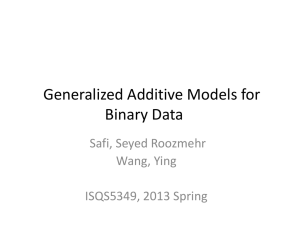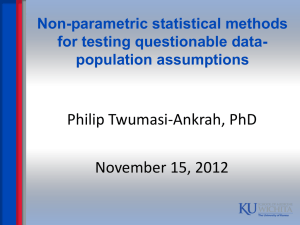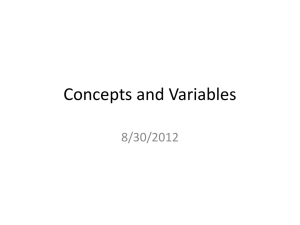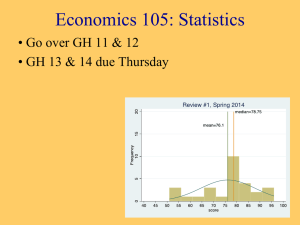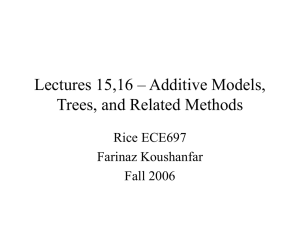GradQuant Sponsered Workshop: Nonparametric Tests
advertisement
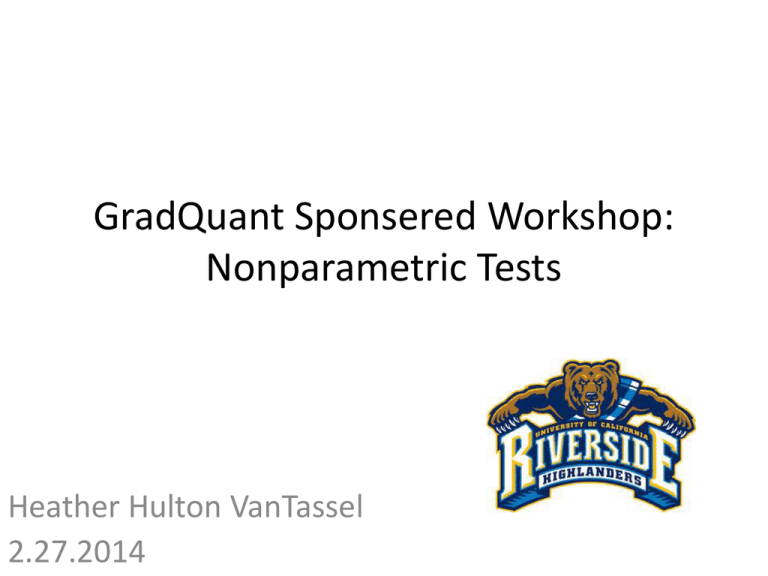
GradQuant Sponsered Workshop: Nonparametric Tests Heather Hulton VanTassel 2.27.2014 Workshop Outline What is a Nonparametric Test? • Definition/Assumptions Basic Nonparametric Tests • Deals with non-normal distributions Advanced Nonparametric Test • Deals with data with a non-fixed model structure Workshop Goal To be equipped with the basic skills of how to analyze nonparametric data! What are the typical assumptions of parametric tests? • Random sampling from a defined population • Characteristic is normally distributed in the population • Population variances are equal (if two or more groups/variables in the design) What are Non-Parametric Tests? Statistical techniques that do not rely on data belonging to any particular distribution Dealing with Non-normal Data Non-normal data? Mathematical Transformations Use nonparametric tools Bring in the outliers Transforming Data Example Before and After log transformation http://www.isixsigma.com/tools-templates/normality/dealing-non-normal-datastrategies-and-tools/ Today’s Focus Non-normal data? Mathematical Transformations Use nonparametric tools Often the best choice! *Especially with small sample sizes Bring in the outliers Non-parametric Counterparts: The Basic Tests Ex// Type of Design Parametric Test Non-parametric Test Two Independent Samples Independent –samples t-test Mann-Whitney U or Wilcoxon Rank Sums Test Two Dependent Samples Dependent-samples t-test Wilcoxon T-test Three or more Independent Samples Between-subjects ANOVA Kruskal-Wallis H Test Three or more Dependent Samples Within-subjects ANOVA Friedman x2 Test Non-parametric Counterparts: The Basic Tests, an example Mann-Whitney U or Wilcoxon Rank Sums Test Type of Design Parametric Test Non-parametric Test Two Independent Samples Independent –samples t-test Mann-Whitney U or Wilcoxon Rank Sums Test https://www.stat.auckland.ac.nz/~wild/ChanceEnc/Ch10.wilcoxon.pdf Non-parametric Counterparts: The Basic Tests, an example Mann-Whitney U or Wilcoxon Rank Sums Test NNA=7 NC=9 https://www.stat.auckland.ac.nz/~wild/ChanceEnc/Ch10.wilcoxon.pdf Non-parametric Counterparts: The Basic Tests, an example Mann-Whitney U or Wilcoxon Rank Sums Test https://www.stat.auckland.ac.nz/~wild/ChanceEnc/Ch10.wilcoxon.pdf Non-parametric Counterparts: The Basic Tests, an example Mann-Whitney U or Wilcoxon Rank Sums Test Testing p-values The hypothesis statements function the same way as the two sample t-test – but we are focused on the medians rather than on the means: https://www.stat.auckland.ac.nz/~wild/ChanceEnc/Ch10.wilcoxon.pdf Non-parametric Counterparts: The Basic Tests, an example Mann-Whitney U or Wilcoxon Rank Sums Test https://www.stat.auckland.ac.nz/~wild/ChanceEnc/Ch10.wilcoxon.pdf Non-parametric Counterparts: The Basic Tests, an example Mann-Whitney U or Wilcoxon Rank Sums Test NNA=7 NC=9 W=75 We FAIL to reject the null hypothesis that Ho: A=B Exact p-values can be calculated using statistical software, such as R and SAS Questions? Restroom Break! Non-parametric Counterparts: What are Non-Parametric Tests? Advanced Techniques Statistical techniques that do not assume that the structure of a model is fixed Today’s focus: Additive regression modelling Advanced Techniques: Nonparametric Regression, Introduction • The aim of a regression analysis is to produce a reasonable analysis to the unknown response function m, Yi m( X i ) i , i 1, , n • Unlike parametric approaches where the function m is fully described by a finite set of parameters, nonparametric modeling accommodates a flexible form of the regression curve Adapted from: www.ms.uky.edu/~mai/biostat277/LN.ppt The Additive Model Recall parametric regression: http://www.d.umn.edu/math/Technical%20Reports/Technical%20Reports%202007-/TR%202007-2008/TR_2008_8.pdf The Additive Model http://www.d.umn.edu/math/Technical%20Reports/Technical%20Reports%202007-/TR%202007-2008/TR_2008_8.pdf The Additive Model The Additive Model http://www.d.umn.edu/math/Technical%20Reports/Technical%20Reports%202007-/TR%202007-2008/TR_2008_8.pdf The Additive Model OLS Regression Additive Modeling http://www.d.umn.edu/math/Technical%20Reports/Technical%20Reports%202007-/TR%202007-2008/TR_2008_8.pdf The Additive Model This is just one type of smoothing method! There are more! Check out some resources! http://www.d.umn.edu/math/Technical%20Reports/Technical%20Reports%202007-/TR%202007-2008/TR_2008_8.pdf The Additive Model Finding smoothing parameters http://www.d.umn.edu/math/Technical%20Reports/Technical%20Reports%202007-/TR%202007-2008/TR_2008_8.pdf The Additive Model • There are a number of approaches for the formulation and estimation of additive models. The back-fitting algorithm is a general algorithm that can fit an additive model using any regression-type fitting mechanism. The Additive Model Many statistical programs, such as R and SAS, offer packages that perform analyses of multiple types of additive models!! P-values and slopes/relationships are calculated for you with programs! To better understand how these are calculated and they types of additive models that are available look at the references that have been used at the bottom of the screens! http://www.d.umn.edu/math/Technical%20Reports/Technical%20Reports%202007-/TR%202007-2008/TR_2008_8.pdf Thank you!

